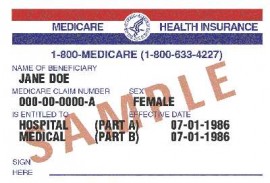Medicare and Medigap insurance can be complex. However, understanding them is essential to making sound financial decisions. Find out more about how Medicare and Medigap plans work, how they work together and which plan is right for you.
Before delving into the various Medigap plan options, it is important to have an basic grasp of how Medicare works and what it covers. First and foremost, there are several parts of Medicare. You can get more information about these parts using the links to the right. Below, there is a synopsis of each part, what it covers and how it works.
Medicare Part A
Part A covers hospitalization and inpatient care, including skilled nursing facility, home health and hospice care. This part of Medicare is “free” if you have worked and paid Social Security checks through payroll deduction for at least 10 years (or 40 quarters). If you have not worked for that minimum amount of time, you must pay a premium to acquire Medicare Part A.
Medicare Part B
Medicare Part B covers outpatient care, doctors’ services and preventive care. This also includes durable medical equipment, hospital outpatient services, lab tests, mental health, x-rays, and some ambulance services. If you are already receiving Social Security at the time that you go on Medicare, you will be enrolled into Part B automatically (you’ll receive a Medicare card by mail reflecting that you have both Part A and Part B). There is a premium for Part B – this is currently $99.90/month. This is typically paid through a Social Security check deduction. If you are not receiving Social Security when you go on Medicare, you should contact Medicare to sign up for Part B.
Medicare Part C
Part C is an optional part of Medicare that is sold through private companies. It is also referred to as Medicare Advantage. You must have Medicare A & B to get a Part C (Medicare Advantage) plan, but if you elect to get a Part C, all of your Medicare benefits are provided through the private insurance company. If you wish to stay with “original” Medicare and get a Medigap plan (Medicare Supplement), you do NOT want to sign up for a Part C plan. There are some significant drawbacks to the Advantage plans, so you must understand any plan coverage/network limitations before electing to go this route.
Medicare Part D
Part D is the part of Medicare that covers prescription drugs. To have drug coverage on Medicare, you must sign up for this part of Medicare. It is also sold through private insurance companies. Typically, there are 30-40 different Part D options available in each county. These are listed on Medicare’s website, and you can compare the plans based on their coverage of your specific and current medications. It is important to sign up for this part of Medicare when you are first eligible, as there is a penalty if you do not do so and then later elect to get Part D.
Medigap Insurance (Medicare Supplements)![]()
Medigap insurance is not part of Medicare. It is a supplemental insurance plan sold through private insurance companies. These plans are Federally-standardized – that is, every company that offers the plans must offer the standardized plans (i.e. an ‘F’ with one company is the exact same as an ‘F’ with another company). See the standardized coverage chart. Rates can vary greatly, however, so it is important to compare based on price and company reputation. All Medigap plans can be used anywhere that takes Medicare nationwide. The most common plan, Plan F, is designed to fill in all of the gaps in the Federal program. There are lower-tier plans that are also common, and less expensive, such as Plan G and Plan N.
Find out more about Medigap plans or get quotes for Medigap plans.
Parts of Medicare: Example Case Studies
 Case Study #1: CHARLES
Case Study #1: CHARLES
Charles continued to work past age 65. He is now age 69 and is planning to retire when he turns 70 in a couple of months. He did NOT take Part B when he turned 65, since he was covered through his employer. He does have Part A because everyone receives that automatically when they turn 65, without any associated costs. First of all, Charles needs to contact Social Security, either through a local Social Security office or online at sign up for Medicare online. Around that same time, Charles can begin to compare the various supplement plans in order to get that lined up to start the same time Part B will start. His enrollment into Part B gives him an open enrollment to enroll in a Medigap plan without any medical underwriting, health questions, physical, etc. Also, he can sign up for a Part D plan, assuming his employer coverage included creditable drug coverage. All of these transitions can be coordinated to occur on the same date – the 1st of a month – the start of Part B and D, the end of the employer insurance, and the start date of the Medigap plan.
Case Study #2: MARY
Mary is turning 65 in three months. She is on retiree insurance from a previous employer that will end when she goes on Medicare. She will receive a Medicare card approximately 2-3 months prior to her 65th birthday. Because she is already receiving Social Security, she will be automatically enrolled into Parts A & B. Her coverage will start the 1st day of the month that she turns 65, and she does not have to do anything to enroll in Medicare. Once she receives that card, or even before with some companies, she can compare and choose between the various supplemental plan options and enroll in a Part D plan to cover her prescription drugs. Due to her turning 65 and going on Medicare for the first time, she is eligible for both a Medigap plan and a Part D plan on an open enrollment basis.
Case Study #3: DORIS
Doris has Medicare A & B and a Medicare Supplement already. Her policy is going up $15/month next month, and she wants to see if there are other options. It is June, though, so does she have to wait for the annual enrollment period? NO, there is no such thing for Medigap plans. This only applies for Part D plans. You can enroll in, change or disenroll from your Medigap plan at any time. So, if Doris wants to change plans, or even if she just wants to see what else is available, she can simply compare the quotes for “like” coverage. In other words, if she has Plan F, she can compare other Plan F quotes. Coverage with “like” plans is the exact same.
What Does Medicare NOT Cover
Medicare covers most things deemed medically necessary, but many people often ask what it does NOT cover. It is important to know. The way Medigap plans work is that they are designed to “follow” Medicare. So, if Medicare pays, the supplement/Medigap plan will pay. If Medicare does NOT pay, the Medigap plan will not pay either. Here are a few things that Medicare does not cover:
- Alternative medicine
- Care received outside of the U.S. (NOTE: This is an exception to the above paragraph, as some of the supplements do include a benefit for foreign travel emergencies)
- Hearing Aids
- Long Term Care
- Cosmetic Surgery
- Experimental procedures
- Vision Care

Frequently Asked Questions About Medicare
Where Can I Use Medicare? Many doctors take Medicare; however, Medicare is not a network-based program, so there is not a provider list or a directory. Medicare is a “fee-for-service” program so doctors are not obligated to take it. It is important to ask any new doctor if they take Medicare. Medigap policies “follow” Medicare, so if your doctor takes Medicare, he/she must take the Medigap plan. If they do not take Medicare, the Medigap plan will not pay either.
How Do I Sign Up for Medicare? If you are already receiving Social Security when you turn 65, you will be automatically enrolled (starting the 1st day of the month you turn 65) into Medicare Parts A & B. If you are not receiving Social Security, you will be enrolled into just Medicare Part A. In this case, if you wish to sign up for Part B also, you would need to contact Social Security to do so (or go to a local Social Security office). If you are still working and wish to sign up
for a plan, you can do so by going to a Social Security office, calling Social Security or going online to the “Apply Online for Medicare” link in the “Medicare Resources” on the right hand side of this page.
Does Medicare Cover Preventive Care? Medicare actually does cover a good deal of preventive care now. This has not always been the case, but starting in 2011, Medicare began to cover many preventive care services that were not covered in the past. A partial list of preventive care items that Medicare now covers are annual physical, diabetes screening, mammograms, pap smears, colorectal screening, and prostate screening.
Do I Need Something In Addition to Medicare? This is certainly completely up to you, but most people on Medicare do find it useful to have something else in addition to “original” Medicare. Many people elect to get a Medigap plan to fill in the gaps in Medicare A & B. With Medigap plans, you can eliminate uncertainty and have predictable, fixed annual medical costs.





